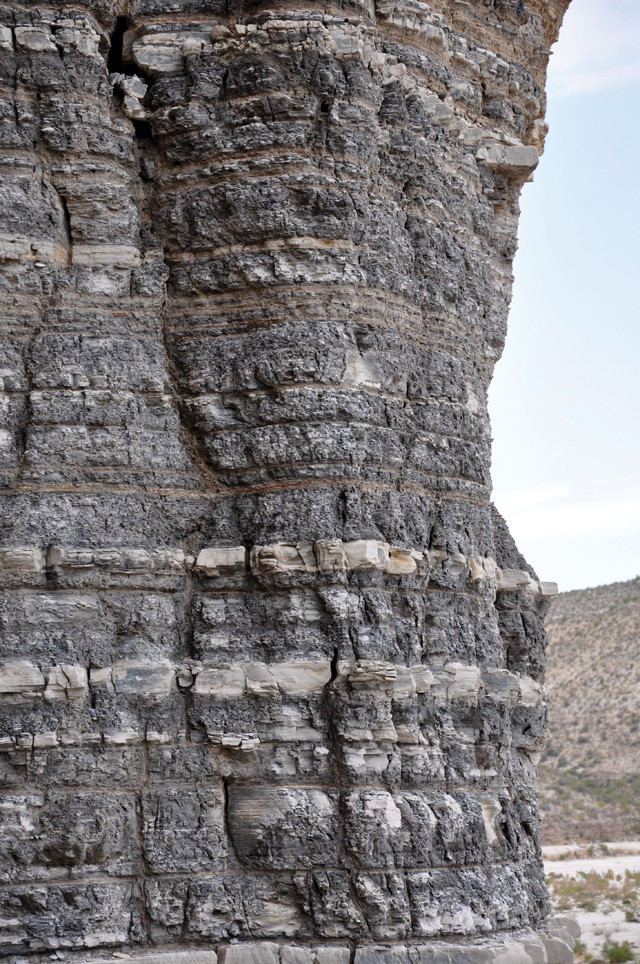
by Bethany Augliere Tuesday, June 5, 2018

A new study using samples from this outcrop — exposing the contact between the Cretaceous Eagle Ford Shale and Austin Chalk formations near Osman Canyon, Texas — suggests the abundant oilfields of the western United States may owe their existence to Cretaceous volcanic ash. Credit: Cin-Ty Lee.
Petroleum and natural gas stores are often found amid rocks — particularly ashbeds — deposited during the Cretaceous, when dinosaurs roamed Earth and abundant volcanic arcs lined the edges of the continents.
“Some regions of the [U.S.], particularly areas where fracking happens, have a lot of ashbeds,” says Cin-Ty Lee, a geochemist at Rice University in Texas. “Why is there this association?”
In a new study published in Scientific Reports, Lee and his colleagues suggest an answer: The abundant ash spewed by those many Cretaceous volcanoes fertilized the ocean, fueling the productivity of huge phytoplankton blooms that would later become crude oil and shale gas.
Lee and his team sampled ash layers from a 13-meter-thick section of the uppermost Eagle Ford Shale and lowermost Austin Chalk formations exposed in a roadcut along Highway 90 near Osman Canyon, Texas. Those rocks formed about 100 million years ago, when much of western North America lay beneath a shallow ocean. “There’s so much ash there — these beautiful records of continuous ashfalls,” Lee says.
Lee’s team analyzed the compositions of the ash and found that the rocks were missing a lot of iron, phosphorus and silicon. “The ashes are so altered that they don’t look anything like when they originally left the volcano,” Lee says, suggesting these elements, which are nutrients for plankton, likely leached from windblown ash that landed in the ocean.
To estimate the amounts of these nutrients that ended up in the ocean from mid-Cretaceous volcanic ash, Lee’s team first needed to understand the composition of the parent material. The researchers measured titanium and zirconium to trace the ash they’d sampled back to its volcanic source. They could then calculate how much of the iron, silica and phosphorus in the original ash source was missing from the ash that ultimately deposited.
They determined that 75 percent of the iron, phosphorus and silicon originally in the ash never reached the ocean bottom, but instead leached into the water. During the Cretaceous, about 10 times more phosphorus was entering the ocean from volcanic ash than today.
“This is potentially a very large flux of nutrients into the oceans,” Lee says. The high levels of nutrients would’ve led to blooms of phytoplankton, which, when they died, decayed and sank, would’ve sucked up much of the oxygen deep in the water column, potentially creating dead zones. Anoxic conditions at the seafloor would’ve then preserved much of the residual organic material, which was eventually buried and converted to oil and gas.
While many studies have focused on how volcanic activity during this time influenced the ocean, few have considered the specific impacts of continental volcanic arcs, says Timothy Lyons, a biogeochemist at the University of California at Riverside, who was not involved in the study. The findings offer new evidence for how ash impacted the ocean during the Cretaceous Period.
A hundred million years ago, the planet was much warmer and more volcanically active than it is today. This greenhouse Earth was characterized by a lack of glaciers and high atmospheric carbon dioxide levels. Additionally, up to 10 percent of the ocean was anoxic, compared to just 1 percent today.
All of these conditions mean that nutrients were abundant in the ocean, and the burial of organic material was favored. “It was an important time for petroleum source beds,” Lyons says. “This work is an important and valuable piece of a larger puzzle.”
© 2008-2021. All rights reserved. Any copying, redistribution or retransmission of any of the contents of this service without the expressed written permission of the American Geosciences Institute is expressly prohibited. Click here for all copyright requests.